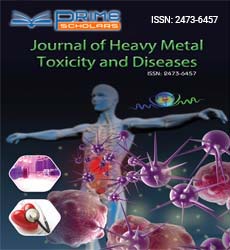Perspective - (2023) Volume 8, Issue 6
The Silent Journey: Unveiling the Mysteries of Bioaccumulation and Biomagnification
Kee Joo*
Department of Science, Incheon University, Korea
*Correspondence:
Kee Joo,
Department of Science, Incheon University,
Korea,
Email:
Received: 29-Nov-2023, Manuscript No. ipjhmct-24-18975;
Editor assigned: 01-Dec-2023, Pre QC No. ipjhmct-24-18975 (PQ);
Reviewed: 15-Dec-2023, QC No. ipjhmct-24-18975;
Revised: 20-Dec-2023, Manuscript No. ipjhmct-24-18975 (R);
Published:
27-Dec-2023, DOI: 10.21767/2473-6457.23.6.55
Introduction
In the intricate tapestry of ecosystems, bioaccumulation and
biomagnification weave a silent but profound narrative of environmental
processes that impact the health of organisms across
trophic levels. These phenomena, driven by the uptake and concentration
of substances through the food chain, hold implications
for both wildlife and human populations. This article unravels
the mysteries of bioaccumulation and biomagnification,
exploring their mechanisms, consequences, and the global implications
for environmental health.
Description
Bioaccumulation refers to the gradual buildup of substances,
often pollutants or toxins, within the tissues of organisms over
time. This process occurs when the rate of intake or absorption of
a substance exceeds the organism’s ability to eliminate or metabolize
it. The substances involved in bioaccumulation are typically
lipophilic (fat-soluble) and may include heavy metals, pesticides,
and certain industrial chemicals. Aquatic environments serve as
hotspots for bioaccumulation due to the persistent nature of
contaminants in water. Organisms such as fish, mollusks, and
plankton accumulate substances from water through respiration,
ingestion, and absorption. For instance, mercury in water can
transform into methylmercury, a highly toxic form that readily
bioaccumulates in fish tissues, posing risks to both aquatic ecosystems
and humans reliant on fish consumption. Several factors
influence the extent of bioaccumulation, including an organism’s
metabolic rate, feeding habits, and the physicochemical properties
of the substance. Longer-lived organisms, high on the food
chain, and those with slower metabolic rates are more prone to
bioaccumulation. Additionally, bioaccumulation is influenced by
environmental factors such as temperature, pH, and the presence
of other substances that may interact with the bioaccumulating
agent. Bioaccumulation can have detrimental effects on
individual organisms and entire ecosystems. High concentrations
of pollutants within an organism can lead to physiological and
reproductive impairments. Moreover, when organisms at lower
trophic levels are affected, predators at higher trophic levels, including
humans, may be exposed to elevated concentrations of
these substances. Biomagnification, an extension of bioaccumulation,
occurs when the concentration of a substance increases at
each successive trophic level in a food chain. This phenomenon
amplifies the levels of certain substances, particularly those with
low degradation rates, as they move up the food chain. Biomagnification
often has profound effects on top predators in ecosystems.
In terrestrial ecosystems, biomagnification can occur
through the food chain, from plants to herbivores to predators.
For example, pesticides applied to crops may accumulate in the
tissues of herbivores, and predators at the top of the food chain
may experience heightened exposure. In aquatic ecosystems, top
predators such as large fish or marine mammals can accumulate
high levels of pollutants through the consumption of smaller
prey. Substances prone to biomagnification often include persistent
organic pollutants (POPs) such as certain pesticides (e.g.,
DDT), polychlorinated biphenyls (PCBs), and some heavy metals
like mercury.
Conclusion
Bioaccumulation and biomagnification, intricate ecological processes,
underscore the vulnerability of ecosystems and human
health to the persistence of certain substances in the environment.
As we navigate the complexities of these phenomena, a
collective effort is required to address their root causes, minimize
exposure, and foster sustainable practices. Through international
collaboration, stringent regulations, and informed decision-making,
we can strive for a future where ecosystems thrive, and the
silent journey of bioaccumulation and biomagnification no longer
poses a threat to the delicate balance of the natural world.
Citation: Joo K (2023) The Silent Journey: Unveiling the Mysteries of Bioaccumulation and Biomagnification. J Heavy Met Toxicity Dis. 08:55.
Copyright: © 2023 Joo K. This is an open-access article distributed under the terms of the Creative Commons Attribution License, which permits unrestricted use, distribution, and reproduction in any medium, provided the original author and source are credited.

